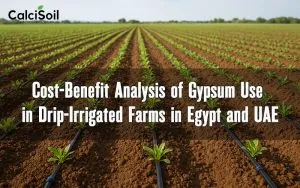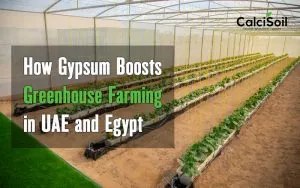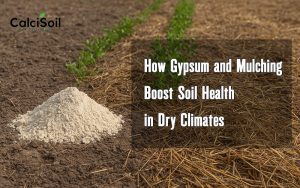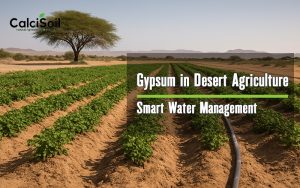
Liming importance in agriculture
In agriculture, liming refers to the application of calcium- and magnesium-rich materials. such as limestone, chalk, or hydrated lime, to soil. This practice is used to neutralize soil acidity, improve plant growth, and increase the activity of soil bacteria. By raising the pH of the soil, liming helps plants develop healthier roots and makes aluminum less toxic to them. It can also enhance drought tolerance and increase the supply of other plant nutrients.
However, it’s important to avoid oversupplying lime, as it can harm plant life. Additionally, industrial byproduct liming materials can also be used to reduce soil acidity and supply nutrients. such as wood ash and steel mill slag. Proper liming is essential for maintaining soil health and promoting successful crop production.
Difference between gypsum and liming
Gypsum and lime are used in agriculture as soil amendments, but they have different properties and effects on soil chemistry. Here are the main differences between gypsum and lime in agriculture.
Chemical composition. Lime, also known as agricultural lime, is a carbonate, oxide, or hydroxide of calcium. It is used to increase soil pH and provide calcium ions for plant uptake. Gypsum is calcium sulfate, providing both calcium and sulfate to the soil system. It does not increase soil pH and is used on soils with a pH greater than 7.
Soil pH. Lime increases soil pH, while gypsum does not. A factsheet titled “Soil Acidity and Liming” explains that gypsum does not change soil pH. and it is recommended to correct soil pH before using gypsum.
Soil structure. Gypsum can improve soil structure, decrease soil compaction, and increase water infiltration at the soil surface. Lime, on the other hand, is primarily used to increase soil pH and provide calcium ions for plant uptake.
Sulfur content. Gypsum is a source of sulfur, which is an essential nutrient for healthy plant growth. Lime does not have the same sulfur content as gypsum.
Solubility. Gypsum is about 200 times more soluble than lime. This greater mobility allows gypsum to help lime better infiltrate the soil.
Application. Both agricultural lime and gypsum can be used on agricultural fields. However, it is essential to perform a soil analysis to determine if the soil needs gypsum or lime. as applying too much gypsum can damage the soil by removing necessary nutrients.
In summary, both gypsum and lime are used to improve soil conditions. But they have different chemical compositions, effects on soil pH, and properties that benefit soil structure and fertility. It is crucial to understand these differences and use the appropriate amendment based on the specific needs of your soil.
Does gypsum replace liming?
As we noticed above Gypsum and lime are both used as soil amendments. but they are not the same and should not be used interchangeably. They have different effects on soil chemistry and are used for different purposes.
Lime is a carbonate, oxide, or hydroxide of calcium, while gypsum is calcium sulfate.
Both gypsum and lime can help improve various nutrient levels in soil, but they have different mechanisms. Gypsum is used to improve soil structure, decrease soil compaction, decrease acidity, prevent water run-off, increase airflow, and dislodge salt. It is a source of calcium and sulfur, which are essential for healthy plant growth. Lime, on the other hand, is used to correct soil pH and boost calcium levels in the soil.
Gypsum should be surface-applied and not incorporated, as it can be toxic to plants if applied directly to soil surface. Lime can be incorporated into the soil and is typically used to raise the pH of acidic soils.
In summary, gypsum and lime serve different purposes in soil amendments. Gypsum is used to improve soil structure and nutrient levels without affecting soil pH. while lime is used to increase soil pH and provide calcium ions. It is essential to understand your soil’s specific needs. and consult with a soil test to determine the most appropriate amendment for your garden or lawn.
When should gypsum be used instead of lime
Gypsum should be used instead of lime in specific soil conditions and for particular purposes. Here are the scenarios in which gypsum is preferred over lime.
High Magnesium (Mg) Soils. Gypsum is preferred over lime in high Mg soils. as the application of lime in such soils can exacerbate problems and lead to poor drainage, compaction, and waterlogging.
Imbalanced Calcium (Ca) and Magnesium (Mg) Levels. In soils where the desired base saturations of Ca and Mg are not attained, gypsum can help. It shifts the Ca and Mg levels to a more balanced state. It’s important to consider the base saturation numbers for Ca and Mg in soil when choosing between lime and gypsum.
Compacted Soil and Excessive Saline Levels. Gypsum helps correct compacted soil and counteracts excessive saline levels, making it a suitable choice for such soil conditions.
In summary, gypsum is preferred over lime in high Mg soils, in soils with imbalanced Ca and Mg levels. and in the presence of compacted soil and excessive saline levels.







